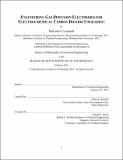Engineering gas diffusion electrodes for electrochemical carbon dioxide upgrading
Author(s)
Leonard, McLain E.(McLain Evan)
Download1251767709-MIT.pdf (23.31Mb)
Other Contributors
Massachusetts Institute of Technology. Department of Chemical Engineering.
Advisor
Fikile R. Brushett.
Terms of use
Metadata
Show full item recordAbstract
Electrochemical carbon dioxide reduction (CO2R) is increasingly recognized as a viable technology for the generation of chemicals using carbon dioxide (CO₂) recovered from industrial exhaust streams or directly captured from air. If powered with low-carbon electricity, CO2R processes have the potential to reduce emissions from chemicals production. Historically, three-electrode analytical cells have been used to study catalyst activity, selectivity, and stability with a goal of incorporating proven materials into larger devices. However, it has been recognized that the limited CO₂ flux through bulk volumes of liquid electrolyte limit the effective reaction rate of CO₂ when using promising catalyst systems. Gas-fed electrolyzers adapted from commercial water electrolyzer and fuel cell technologies have motivated researchers to explore combinations of porous electrodes, catalyst layers, and electrolytes to achieve higher areal productivity and favorable product selectivities. Present art demonstrates that high current density production (>200 mA cm₋²) of valuable chemicals at moderate cell voltages (ca. 3-4 V) is achievable at ambient conditions using electrolysis devices with catalyst-coated gas diffusion electrodes (GDEs). However, beyond short durations (1-10 h) stable performance outcomes for flowing electrolyte systems remain elusive as electrolyte often floods electrode pores, blocking diffusion pathways for CO₂, diminishing CO2R selectivity, and constraining productivity. Systematic study of the driving forces that induce electrode flooding is needed to infer reasonable operational envelopes for gas-fed electrolyzers as full-scale industrial devices are developed. In this thesis, I investigate GDE wettability as a prominent determinant of gas-fed flowing electrolyte CO₂ electrolyzer durability. To do this, I combine experimental and computational approaches. First, I use a flow cell platform to study transient evolution of activity, selectivity, and saturation to identify failure modes, including liquid pressurization, salt precipitation, electrowetting, and liquid product enrichment. Next, I use material wettability properties and reactor mass balances to estimate how enriched liquid product streams might defy non-wetting characteristics of current GDE material sets. Finally, I construct computational electrode models and vary surface chemistry descriptors to predict transport properties in partially saturated electrodes. Specifically, I consider how saturation evolves in response to relevant scenarios (i.e., electrowetting and liquid products) that challenge CO₂ electrolyzer durability.
Description
Thesis: Ph. D., Massachusetts Institute of Technology, Department of Chemical Engineering, February, 2021 Cataloged from the official PDF of thesis. Includes bibliographical references (pages 219-233).
Date issued
2021Department
Massachusetts Institute of Technology. Department of Chemical EngineeringPublisher
Massachusetts Institute of Technology
Keywords
Chemical Engineering.